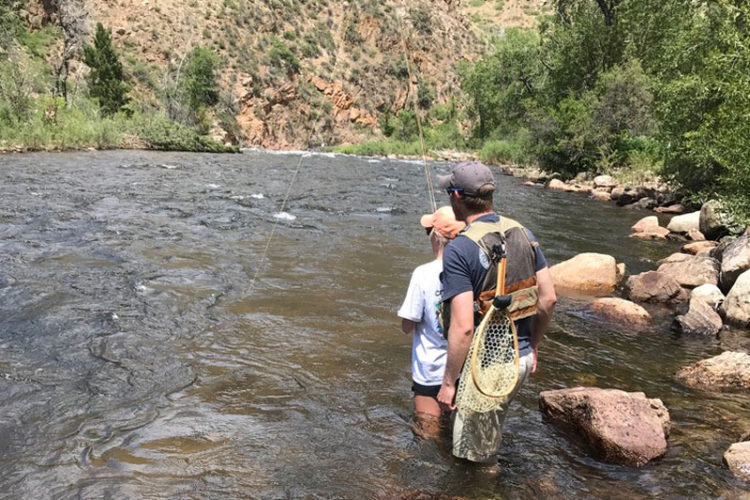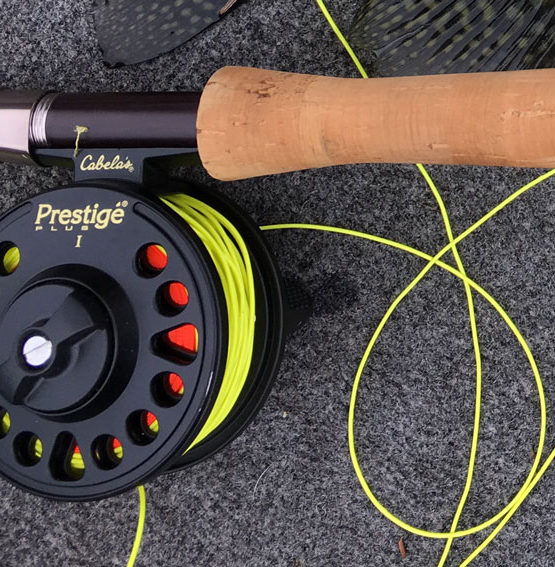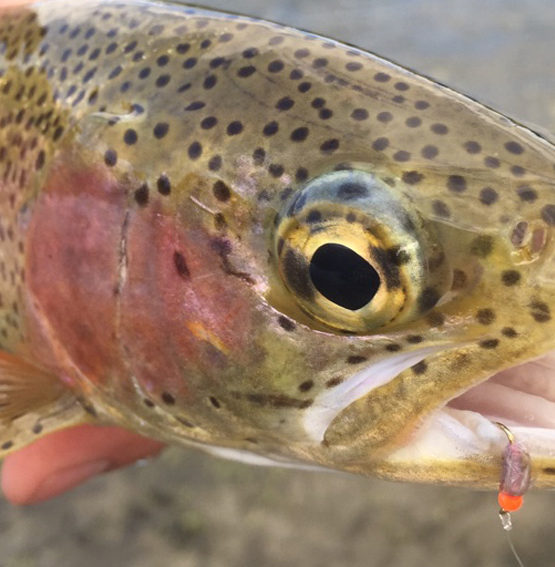When you first get into fly fishing, one of the most important skills you can learn, is how to read a river. And that’s exactly what we’re going to cover in this article.
A patient soul, my father first taught us how to fly fish on beaver ponds. And I can see why he did so.
For the most part, beaver ponds, though typically surrounded by fly fishing minefields — looming willow branches; reed-shrouded, ankle-breaking connection channels; snaggy dams, and other treacherous traps — provide numerous benefits to novice fly fishermen. A series of tiered, brook-fed ponds provide for easy, approach-from-below cover, generally clear backcasting freedom, slow moving currents, plenty of ideal insect breeding conditions, and, above all, obvious fish-holding and feeding zones.
As long as we were stealthy and quiet in our approach, didn’t spook the pond with a sloppy first cast, and placed our fly near the pond’s inlet (or anywhere we saw surface rings) we were almost guaranteed several easy-to-see strikes and landed brook trout. As for fly fishing cascading, swiftly flowing mountain rivers, on the other hand… not so much.
It wasn’t until early-adulthood that I took the time to learn the ins and outs of reading a river. And boy did it pay off.
Similarly, many beginning anglers learn the basics of equipment, rigging and casting but quickly lose interest because they haven’t committed enough time to the most important fly fishing discipline: reading a river. Therefore, learning how to read a river may be the single most important thing you do in your early fly fishing career. And if you do so, it will be a long and rewarding one.
With that in mind, I present to you, How To Read A River: 9 Key Tips To Catch More Trout.
Disclaimer: This post may contain affiliate links, meaning we will receive a small commission (at no cost to you) if you click through and make a purchase.1. Look For Slow, Deep Pockets
In my life as a fly fisherman, I’ve heard this adage hundreds of times: “trout are lazy.” While it’s an easy quip to remember, I give trout a lot more credit. Instead of thinking that they are lazy, I think, “trout are efficient.”
Thinking about this in another way, put yourself in their fins. You try swimming upstream, all day and all night, in a strong river current as you spend most of your work-a-day life trying to stay fed while trying not to become food yourself. When you see it this way, it’s a lot easier to understand why river trout seek deeper pockets of slower moving water where, while hidden from predators above, both air and food flow to them rather than the other way around.
Related Content:
- 9 Killer Nymphing Tips For Beginners
- When Is Fly Fishing Season?
- Can You Fly Fish Anywhere?
- 11 Tips For Night Fishing The Taylor River
- Fishing The Bighorn River In Montana: The Ultimate Guide
2. Look For Well-Oxygenated Runs (Follow The Bubbles)
I’ve only gone scuba diving a few times in my life. Every time I have, as soon as I don all of the expensive equipment that will allow me to do so, I’m immediately and keenly aware of how ill-equipped I am to breathe underwater. This realization is only accentuated once I plunge myself into some form of aquatic environment, i.e. an ocean, lake, etc., and take my first look around.
Inevitably, this thought hits me right away: I don’t belong here. Happily, fish do belong there and are, again, efficiently designed to breathe pretty much the same air we do, with the main exception being that they are pulling the oxygen from their aquatic surroundings.
Therefore, as living beings with a strong, innate propensity to want to breathe, they tend to congregate where water-bound oxygen is plentiful.
Logical, right?
As fly fishing river-readers, we combine tip #1 with tip #2 and look for slower-moving, deeper sections of river characterized by oxygen-producing features at or above their entrance. In other words, look for a deep, slow runs just beyond a waterfall, a stretch of rapids, a shallow rock-strewn straight, a sharp bend or something similar. Often given away by a trail of surface bubbles or foam, I’ve seen runs like this host hundreds of actively feeding trout.
3. Trout Prefer Conveyor Belts Of Food
This is an easy one. Just as they seek areas where it’s easy to breathe, trout love places where food flows right into their awaiting gullets. The good news? These areas typically align with where the O2 is high.
Additionally, trout are magnificently predatory. Whether aquatic born or terrestrial, critters that find themselves in the clutches of a river’s rather treacherous forces — the same as described above — are, as such, about as safe as a wounded tuna among a swirling pack of frenzied hammerheads.
Note: The tips above notwithstanding, insect-eating fish also congregate where plentiful food is falling from overhanging bushes, trees and other flora, where flies mate and then fall back into the river to live the last few waning moments of their lives. This is known as a “spinner fall” and it’s a thing to behold when it happens. A spinner feeding frenzy is easy to identify. You’ll see what I mean when you first experience one.
4. Assess The Conditions
This tip could (and probably should) come first. When reading a river, context is everything. Without getting into the physiological or philosophical weeds here, it can be said about every living thing on the planet that conditions determine behavior.
Trout are no different, of course, so they will behave in a radically different way in the dead of winter than they will in late summer. They will act differently in the morning than they will when the sun is high. And, as a rule, they are sharply wary of looming winged and furry predators (unless they’re losing their minds in a Drake hatch-induced feeding frenzy).
5. Consider River Flow
Trout behave very differently depending upon high or low flows. Because the CFS (Cubic Feet Per Second) ranges are different for every river, it’s important to know each river’s high, low and mid-range flows.
A low flow value on one river will be a high flow value on another. In other words, a CFS value may constitute a trickle on a big river whereas the same CFS value means a torrent on a small one.
At the very least, knowing the particular CFS of the river you intend to fish will have everything to do with how you fish it. Plus, dropping a few terms like CFS when chatting with friends at summer cocktail parties will make you sound really cool — at least to yourself.
6. Consider Time-of-Day
As noted previously, morning and evening generally present better conditions for fly fishing success.
It’s cooler; shadows are longer; insect hatches happen with greater frequency; and overhead predators can’t see through surface glare as easily. This translates into knowing when it’s best to fish and when it’s best to kick back with a hearty hoagie and a cold one.
7. Pay Attention To Water Clarity
Trout behave differently depending upon whether the river water is clear, off-color, murky or downright chocolate-milk-muddy.
Among other things, river clarity has a lot to do with how you’ll approach a run; how sensitive the fish will be to your presence; what type of flies they’ll be able to see, and more. Generally speaking, the lower the flow, the greater the clarity, but that’s not always true, and clarity can and often does change on a moment’s notice.
8. Assess the Spot You’re Intending to Fish.
You’re finally at river’s edge and the moment of truth is at hand. You’ve found a nice run with all the key features and conditions we’ve been describing flowing gloriously right there in front of you.
So, what’s next?
You’re approach, that’s what.
This is where many a novice and eager angler blows it. They trudge sloppily into the river and start-a-castin’. Meanwhile, all the trout they might have had a crack at have already been alerted to their presence and have either scattered or have just turned off their feed-o-meter until they believe the coast is clear.
Instead, this should be your “be the ball” moment. Before wading in, a good fly fishing angler will stand a fair distance away from their identified run, take several deep breaths, calm the heart rate, pee if her or she has to, study the environmental setting, the bugs fluttering around them or crawling and/or hopping below, become one with the river and, only after going through all of the above, determine their action plan.
At the very least, this plan should include:
Considering Sun Angle and Shadows
Casting a moving shadow over the intended fishing spot isn’t going to ingratiate you with your finned quarry.
Assessing Snag Potential
Where are the snag hazards? In the fly fishing world, there is nothing quite as buzz-killing as a first or second cast snag with a fresh rig at the foot of a tasty run. It will happen, I assure you, but if you pay homage to the snag gremlins by planning ahead, they may go easy on you.
By the way, identifying cast and drift snag hazards should be done as if, when positioned on your run as you want to be, you picture yourself inside an invisible sphere of potential snags. In other words, snags can come from above, below, behind, ahead and, inevitably, right on your person. I can’t tell you how many times I’ve been my own worst snag enemy by carelessly hooking up on my hat, my gear or, worse, my ear.
Evaluating Wind and Cast Type
Closely associated to the above, wind is both a cast style determiner and a snag or gnarl accentuator but, if you figure out how to make it work for you more than against you, it’s trip-ruining potential will be minimized.
For example, a wind-induced riffle on an otherwise placid-surfaced run helps to obscure you from a trout’s view. Combine that with the right cast for the wind velocity and direction, and that underwater snag you think you just got may suddenly dart upstream on you, if you know what I mean.
Determining Your Best Approach
Depending upon many of the considerations discussed above, I’ve approached runs in near army crawling silence or, at the other extreme, as if I were the one-man percussion band in the traveling circus. Channel your inner river-reading Yoda, become one with the your setting, and make your approach as conditions dictate. Do so, and you will be rewarded a lot more often.
9. Don’t Ignore the Shallows
Every rule has an exception, right?
Yes, while all of the normalities noted above constitute a trout’s behavioral rule set, the exception is that they can sometimes be found and caught right out of the rapidly flowing shallows when the sun is highest in the sky.
On many occasions, when things get slow in the traditional spots, I’ll try a few casts into the shallower runs only to be pleasantly surprised by a furious take. We arrogant fly-fishing humans think we know, and can see everything, but the truth is, many an underwater hollow, shelf, or unseen structural anomaly can provide perfectly camouflaged cover for an aggressive trout or two.
As you work on your river reading prowess, try casting into the shallows now and again, especially if the shallower section happens to be just above the deeper run behind it.
You’re welcome.
Final Thoughts
In a previous blog, I wrote about the joy I get from the endless learning opportunities fly fishing provides. Learning to read a river and, more precisely, why trout behave as they do within its mysterious confines, falls right into that category. And as I write about it, I realize just how much more there is to know.
Do you have any other tips for reading a river? Be sure to comment below. We love hearing from our readers!











You all have a great site with great info. Thanks. Your info reminds me of factors we all tend to forget or never knew.
If only I paid attention to those ideas I know to be true. Thanks for the reinforcement of sound fishing. I should read this arrival every 6 months to get through my thick German-Irish head.